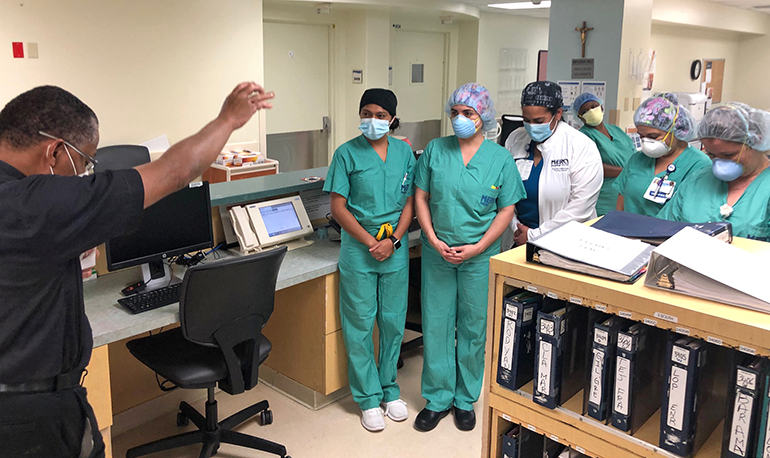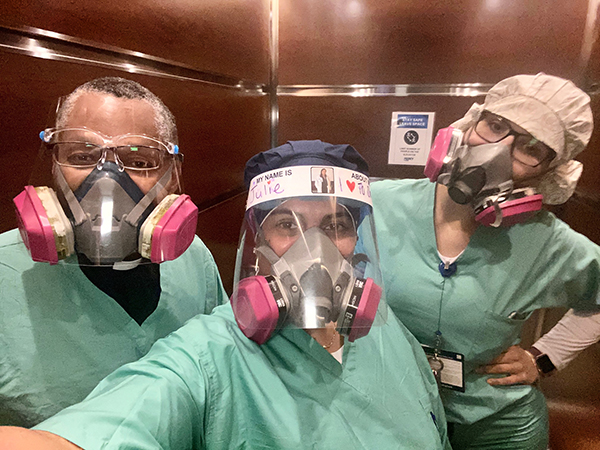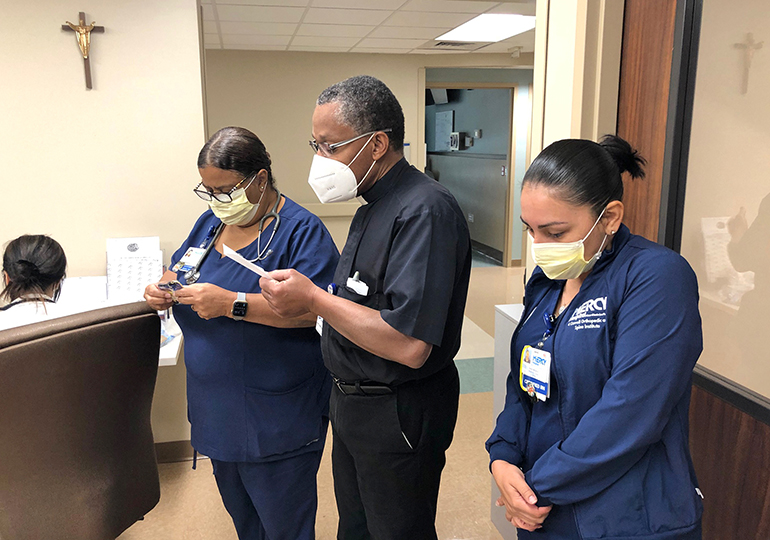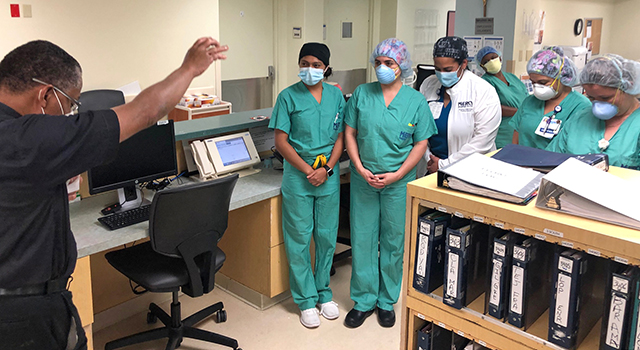By Tom Tracy - Florida Catholic

Photographer: COURTESY
Father J. Sterling Laurent, a priest chaplain at Miami's Mercy Hospital for the past nine years, and a priest in residence at nearby St. Kieran Parish, prays with medical staff at Mercy. The chaplain's day usually begins around 7 a.m. by praying with the nurses, doctors and medical staff at the start of their morning shifts.
MIAMI | Earlier in 2020, during South Florida’s first spike of COVID-19 cases, a woman flew down from New York on short notice and phoned Mercy Hospital from the Miami airport.
She was begging to see her father in an intensive care unit. But as with so many family members with loved ones hospitalized around the country with COVID, visitors and volunteers aren’t permitted to enter the COVID ward for safety reasons.
“She could not pass the security area here but we went down to meet her — the chief medical officer came down as well, and in an instant that daughter could speak with the doctors,” said Father J. Sterling Laurent, a priest chaplain at Mercy Hospital for the past nine years and a priest in residence at nearby St. Kieran Parish.
“We arranged a Facetime chat so she could talk to her dad for thirty minutes; we assured that lady that we would pray with her any time,” the priest said of the visitor from New York.
Heartbreaking situations and improvised communication measures between patient and family have been defining features of hospital chaplaincy in 2020, now likely to continue into next year as a record-breaking and widespread surge of COVID-19 patients overwhelms some hospitals and prompts more than a few state governors to reimpose strict lockdowns.
In Florida, which saw surges in late spring and early summer, the number of daily new cases peaked at over 17,000 Nov. 27 and Dec. 26, about 2,000 more than the July 12 high.
“It was very difficult for the patients and families when the infection was first going up and we put restrictions that the families could not come here — it was hard for them not to see their loved ones and their level of stress increased,” Father Laurent said.
There is hope among hospital staff, Father Laurent said, that the record number of hospitalizations seen in July won’t be seen again, but public health experts are warning of very difficult months ahead following the Thanksgiving and Christmas holidays and in advance of a widespread roll-out of various COVID vaccines.
“There is no way we can take away the difficult part of the situation and it is a confusing time for families,” Father Laurent said.
Most of the COVID-positive patients he has prayed with are well over 50 years of age, but he said he has seen one or two patients as young as 40.
A Catholic hospital chaplaincy offers many of the same services as a parish, including daily Mass and access to the sacraments. Two years ago, the staff at Mercy even managed to arrange for an on-site Protestant wedding on short notice, at the behest of a terminally ill father determined to attend his daughter’s ceremony. The wedding was held in his hospital room.
A Catholic patient might ask Father Laurent — or one of the three other priest chaplains affiliated with Mercy Hospital — for anointing of the sick, to hear a confession or to receive Communion. Mass continues to be celebrated twice a day — one in English, one in Spanish — in Mercy’s second-floor chapel, and piped into patients’ rooms via closed-circuit television. Four priests, one woman religious and a rabbi serve as chaplains.

Photographer: COURTESY
Father J. Sterling Laurent, a priest chaplain at Miami's Mercy Hospital for the past nine years, and a priest in residence at nearby St. Kieran Parish, takes a selfie with some of the medical staff at Mercy, all outfitted in protective gear during the COVID-19 pandemic.
To physically visit patients with COVID, the priest chaplain has to follow the same safety protocol as medical staff: wearing two face masks, a double set of gloves, full body gown, a face shield — and then changing into a fresh set of equipment before moving on to another patient.
Father Laurent said that as the pandemic has progressed, the chaplains and staff have honed their methods of keeping patients connected to their families through communications technology.
Mercy has invested in a set of two new iPads for each of its units so that video chats — or at the very least phone calls — can be arranged to connect patients and family. The nurses are also trained in setting up video chats and using cell phone tools like Facetime and WhatsApp.
The novelty of some of those applications is that they can link together multiple family members and their loved one simultaneously.
“In terms of end of life, we had a situation where the whole family was present (online) within five minutes of the death of the family member,” Father Laurent said. “They pray with us, and that lowers the level of stress.”
In general, a priest chaplain like Father Laurent must be available to serve any time of day or night. The chaplain’s day usually begins around 7 a.m. by praying with the nurses, doctors and medical staff at the start of their morning shifts.
“We gather for prayer and anything in particular they want to pray about, for their safety,” said Mike Garrido, Mercy Hospital’s vice president of mission integration.
Mercy is part of HCA East Florida Division and the only Catholic hospital in the Miami-Dade area.
“Our mission here is to fulfill the mission of the Sisters of St. Joseph of St. Augustine and that is why we continue to do what we do,” said Garrido. “In this pandemic, with the fear of getting infected, our chaplains have drawn on their faith and encouraged the community to meet face to face and with family and loved ones.”
David Donaldson, CEO of Mercy Hospital, reinforced the point that Mercy has adapted some of its operations to prioritize safety while continuing to fulfill the spiritual needs of the community through its embrace of technology.
“Throughout the pandemic, our pastoral care team has remained onsite to support our patients’ emotional well-being,” Donaldson said in a statement. “Since 1950, Mercy Hospital has responded to our country’s most significant healthcare crises with compassion and dignity. Our pastoral care department’s response to COVID-19 will undoubtedly be another important chapter of our history.”

Photographer: COURTESY
Father J. Sterling Laurent, a priest chaplain at Miami's Mercy Hospital for the past nine years, prays with medical staff at Mercy. “We gather for prayer and anything in particular they want to pray about, for their safety,” said Mike Garrido, Mercy Hospital’s vice president of mission integration.

